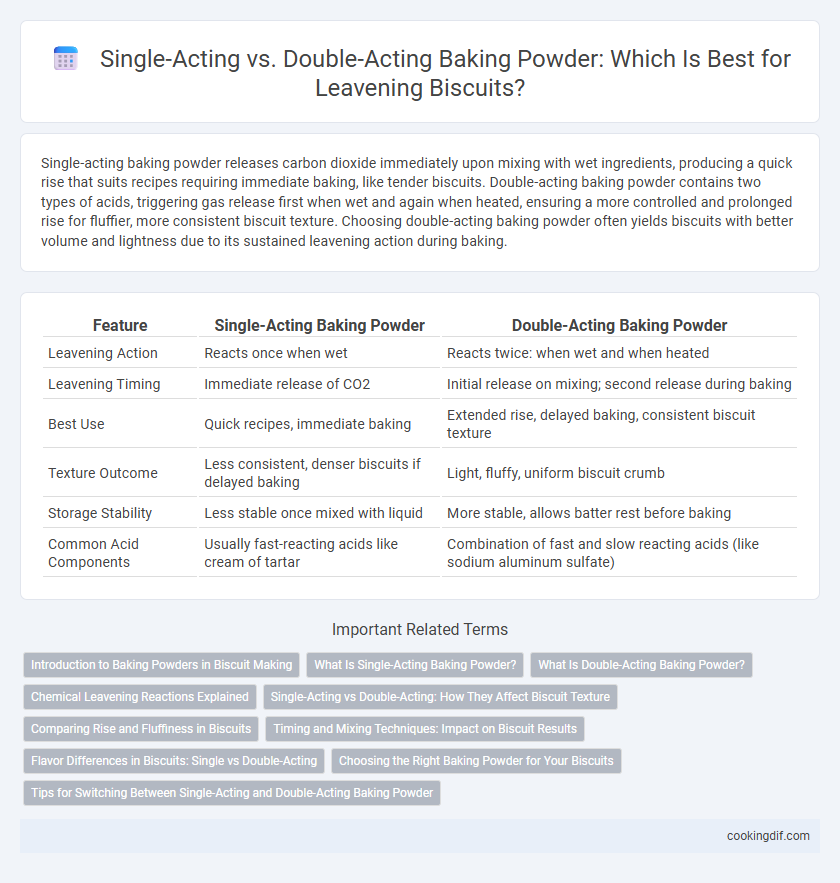Single-acting baking powder releases carbon dioxide immediately upon mixing with wet ingredients, producing a quick rise that suits recipes requiring immediate baking, like tender biscuits. Double-acting baking powder contains two types of acids, triggering gas release first when wet and again when heated, ensuring a more controlled and prolonged rise for fluffier, more consistent biscuit texture. Choosing double-acting baking powder often yields biscuits with better volume and lightness due to its sustained leavening action during baking.
Table of Comparison
| Feature | Single-Acting Baking Powder | Double-Acting Baking Powder |
|---|---|---|
| Leavening Action | Reacts once when wet | Reacts twice: when wet and when heated |
| Leavening Timing | Immediate release of CO2 | Initial release on mixing; second release during baking |
| Best Use | Quick recipes, immediate baking | Extended rise, delayed baking, consistent biscuit texture |
| Texture Outcome | Less consistent, denser biscuits if delayed baking | Light, fluffy, uniform biscuit crumb |
| Storage Stability | Less stable once mixed with liquid | More stable, allows batter rest before baking |
| Common Acid Components | Usually fast-reacting acids like cream of tartar | Combination of fast and slow reacting acids (like sodium aluminum sulfate) |
Introduction to Baking Powders in Biscuit Making
Single-acting baking powder releases carbon dioxide gas immediately upon exposure to moisture, providing a quick rise that suits fast baking processes but may limit biscuit fluffiness. Double-acting baking powder contains two types of acids, releasing gas once when wet and again when heated, resulting in a more consistent and sustained leavening effect ideal for flaky, tender biscuits. Choosing the appropriate baking powder critically influences biscuit texture, volume, and overall quality.
What Is Single-Acting Baking Powder?
Single-acting baking powder contains an acid that reacts immediately when mixed with wet ingredients, releasing carbon dioxide for leavening biscuits. It requires immediate baking to ensure proper rise, as the leavening effect occurs in one stage only. This type of baking powder is ideal for recipes like biscuits that are baked right after mixing to achieve a light, fluffy texture.
What Is Double-Acting Baking Powder?
Double-acting baking powder contains two types of acids that react at different times during the baking process, providing an initial rise when mixed with wet ingredients and a secondary rise when exposed to heat. This dual reaction helps create lighter, fluffier biscuits by ensuring consistent leavening throughout baking. Compared to single-acting baking powder, which releases gas only once upon mixing, double-acting baking powder offers improved texture and volume in biscuits.
Chemical Leavening Reactions Explained
Single-acting baking powder releases carbon dioxide gas immediately upon mixing with wet ingredients, causing a rapid leavening reaction ideal for quick baking processes. Double-acting baking powder contains two types of acids: one that reacts at room temperature and another that activates under heat, providing a prolonged leavening effect that ensures consistent biscuit rise throughout baking. Understanding these chemical leavening reactions helps bakers choose the appropriate leavening agent to achieve desired biscuit texture and volume.
Single-Acting vs Double-Acting: How They Affect Biscuit Texture
Single-acting baking powder releases carbon dioxide immediately upon mixing with wet ingredients, resulting in a quick rise that can produce denser, less flaky biscuits. Double-acting baking powder contains two types of acids, one that reacts at room temperature and another that activates with heat, ensuring a prolonged leavening effect that enhances biscuit fluffiness and tenderness. Choosing double-acting baking powder is often preferred for biscuit recipes to achieve a light, airy texture with consistent rise throughout baking.
Comparing Rise and Fluffiness in Biscuits
Single-acting baking powder releases carbon dioxide immediately when moistened, producing a quicker rise but often resulting in less fluffy biscuits. Double-acting baking powder generates gas in two phases--once when wet and again when heated--yielding a taller, lighter, and more tender biscuit texture. Using double-acting baking powder enhances leavening by maintaining consistent rise and improved fluffiness throughout the baking process.
Timing and Mixing Techniques: Impact on Biscuit Results
Single-acting baking powder releases carbon dioxide immediately upon contact with moisture, requiring immediate mixing and baking to achieve optimal biscuit rise, whereas double-acting baking powder produces gas in two phases--once when moistened and again when heated--offering greater flexibility in timing. Proper mixing techniques, such as gentle folding, are crucial to preserve the trapped gas bubbles and prevent overworking the dough, which can lead to dense biscuits. Understanding the timing differences between single- and double-acting agents helps bakers control texture and flakiness for consistently light, airy biscuits.
Flavor Differences in Biscuits: Single vs Double-Acting
Single-acting baking powder produces a subtle, consistent rise with a milder flavor, allowing the natural buttery and sweet notes of biscuits to shine through. Double-acting baking powder creates a more pronounced rise with a slightly tangier aftertaste due to its two-phase reaction, which can subtly alter the biscuit's overall flavor complexity. Choosing single-acting powder enhances pure biscuit taste, while double-acting introduces a layered flavor profile with a light acidity.
Choosing the Right Baking Powder for Your Biscuits
Single-acting baking powder reacts once when mixed with wet ingredients, providing immediate leavening, making it suitable for quick baking processes. Double-acting baking powder produces two reactions--one at mixing and another when heated--ensuring consistent rise and fluffier biscuits. Choosing double-acting baking powder is ideal for achieving light, tender biscuits with optimal texture and volume.
Tips for Switching Between Single-Acting and Double-Acting Baking Powder
When switching between single-acting and double-acting baking powder for leavening biscuits, adjust baking time and mixing methods because single-acting releases gas immediately upon wetting, requiring prompt baking to prevent flat biscuits. Double-acting baking powder emits gas in two phases, allowing more flexibility in mixing and baking timing, which can help achieve consistent rise and texture. To maintain biscuit lightness and fluffiness, reduce single-acting quantity by about half or increase double-acting slightly, while monitoring dough consistency for optimal results.
Single-acting baking powder vs double-acting baking powder for leavening biscuits Infographic

 cookingdif.com
cookingdif.com